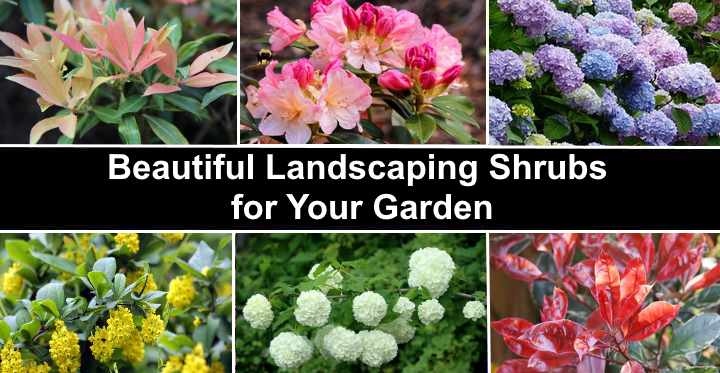In order to have a well-rounded garden, it is important to have a variety of shrubs and bushes. These plants can provide year-round beauty with flowering evergreens during spring, summer, and autumn. Additionally, different types of perennial bushes can be used as low-growing borders, while decorative bushes with colorful leaves can add to the overall aesthetic.
When selecting shrubs for your garden, it is important to consider their maintenance requirements. Opting for low-maintenance varieties can save time and effort while still producing a beautiful result. By selecting the right shrubs, you can create a stunning landscape with minimal care.
This article offers suggestions for landscaping bushes suitable for gardens of any size. It highlights the best options for full-sun and partial-shade areas, as well as low-growing evergreens that provide ground cover. With the right shrubs in place, you can enjoy a beautiful and vibrant garden all year long.
How to Choose Shrubs For the Landscape
Incorporating shrubs into your garden landscape can bring numerous benefits. When selecting landscaping bushes, it is essential to consider factors such as the shrub’s flower color, sunlight requirements, and mature size. Additionally, you must determine the USDA growing area and the amount of maintenance you are willing to undertake.
There are many visually appealing landscaping bushes to choose from. If you prefer low-maintenance options, evergreen shrubs like junipers, spruces, and boxwoods are popular choices that provide year-long greenery. Alternatively, colorful blooming bushes can add a burst of color and pleasant floral aromas throughout the spring, summer, and fall. Some dwarf or low-growing bushes have an attractive, spherical shape without requiring pruning.
With careful consideration and selection, shrubs can enhance the beauty and appeal of your garden while minimizing the amount of upkeep required.
Different Types of Shrubs and Bushes For Landscaping (With Pictures and Names)
Color, privacy, lovely blooms, and pollinators may all be provided by attractive landscaping shrubs in your garden. Choosing the ideal shrubs for your yard may be difficult, since there are literally thousands of alternatives to pick from. For any size of yard or garden, check out the following low-maintenance bushes.
Flowering Shrubs for Your Garden Landscape (With Pictures and Names) – Identification Guide
Hydrangeas

Hydrangeas are a popular group of ornamental flowering bushes that produce a wide variety of colorful blooms ranging from white to pink, purple, red, and blue. With over 70 species available, hydrangeas are a large and bushy type of flowering shrub that also make great ground cover due to their large leaves and low maintenance requirements.
The flowers of hydrangeas typically bloom in early spring and last until early fall. Some hydrangea varieties produce clusters of cone-shaped blossoms, while others have large, colorful, and fragrant balls of flowers. Planting hydrangeas in your garden during the summer months will provide you with a bountiful supply of cut flowers for use in home decor.
There are several well-known hydrangea cultivars that feature beautiful flowers, including the Hydrangea arborescens ‘Annabelle’ with its large white blooms, the Hydrangea paniculata ‘Magical Moonlight’ with green-white cone-shaped flowers, and the Hydrangea ‘Double Dutch Edam’ with its star-shaped flowers. When selecting hydrangeas for your garden, it is important to consider your growing zone, which typically ranges from 3 to 9, as well as the plant’s size requirements, which can range from 3 to 10 feet. To thrive, hydrangeas need rich, damp soil and full sunlight to partial shade. For most gardeners, hydrangeas are relatively easy to care for.
Camellias

Camellias are a popular group of flowering bushes that produce an array of colors ranging from white to pink and red. With over 3,000 cultivars and hybrids, there are plenty of options to choose from to add to your garden. If you’re looking for a smaller version of the flowering shrub, there are dwarf cultivars available.
Camellia bushes are usually the first to bloom in early spring and can be trained to grow against a wall, producing a stunning floral display during the summer. These bushes have single or double blooms in shades of pink, white, and red. Camellias are a great choice if you want to add colorful blooms to your garden.
Here are some examples of Camellia shrubs that do well in full to partial sun:
- Camellia ‘Tricolor’ is a hardy plant that requires minimal care and produces double blooms.
- Camellia ‘Cinnamon Lady’ has lovely white blooms and crimson-green leaves.
- Camellia japonica ‘Don Mac’ grows in a thick pyramid-shaped shrub and produces huge crimson blooms.
Camellias are easy to grow and do best in neutral to acidic soil that is well-drained. They thrive in full to partial sun conditions and are a great choice for glossy green foliage and colorful blooms in your garden.
Viburnum

Viburnum is a charming and diminutive flowering shrub that is perfect for any garden landscape. This small rounded shrub produces star-shaped flowers that come in various forms and colors, including white or pink blooms. Viburnum shrubs are evergreen or deciduous, and they produce leathery oval leaves that add to their aesthetic appeal.
Viburnum shrubs grow to be around 3 to 5 feet tall and broad, making them ideal for foundation planting, hedging, or as a border plant. The plant’s white flower clusters add to its beauty throughout the summer, and in the autumn, the leaves change color, turning orange, burgundy, or purple.
If you’re looking to add Viburnum to your garden landscape, there are a few things to keep in mind. The plant is low-maintenance, pest-free, and grows best in zones 7 to 9. It also thrives in full sun or partial shade conditions. With its charming flowers and attractive foliage, Viburnum is an excellent choice for any garden.
Azalea (Rhododendron spp.)

Azaleas are a great choice for adding colorful flowers to your garden in the springtime. With hundreds of different cultivars available, you can find azalea bushes in shades of pink, white, purple, red, and yellow. These flowering shrubs belong to the rhododendron genus and are available in various sizes and shapes, making it easy to find the perfect fit for your landscaping needs. Some azalea cultivars are hardy enough to withstand harsh winter conditions.
Azalea flowers come in different types, including simple blossoms with delicate petals, double flowers with contrasting colors, and double hose-in-hose flowers. Two types of rhododendrons, the evergreen Rhododendron Tsutsusi and the deciduous Rhododendron Pentanthera, are also included in this group.
Growing zones for azaleas are typically between 3 and 9, and they prefer partial sun and well-drained soil. These low-maintenance plants are easy to care for and perfect for beginner gardeners.
Rose Bushes

Rose bushes are well-known for their magnificent flowers, fragrant scents, and winter hardiness, and there are numerous stunning hybrids of rose bushes in various color variations.
Climbing roses, tiny roses, floribunda, and shrub roses are the best types of landscaping roses. Regular pruning encourages masses of scented flowers to appear, and Rose shrubs bloom all summer long with rosette flowers.

You may plant a rose tree as a lawn or specimen tree to create a stunning landscape feature in your garden. A solitary slender stem sits atop a rounded flowering canopy. Climbing roses may grow up to 20 feet (6 meters) long to cover a wall or fence with eye-catching rose bushes.

- Growing zones: 4 to 10, depending on the variety
- Size: 2 to 6 ft. (0.6 – 1.8 m) tall
- Conditions: Full sun
- Difficulty: Medium to hard, depending on the cultivar
Crape Myrtle (Lagerstroemia)

In Florida and other subtropical places, crepe myrtles may be red, pink, purple, or white. Showy white, pink, or crimson crinkly blooms bloom early in the summer and last until late in the autumn on the small, fast-growing woody shrubs. In the fall, glossy dark green oval or lanceolate leaves turn yellow, orange, and maroon.
In a hot summer landscape, crepe myrtle blossoms are stunning. The shrub’s lush, glossy leaves contrast with the vibrant hues. An informal hedge, screen, specimen shrub-like tree, or foundation planting are all examples of landscape uses for crape myrtle plants.
- Growing zones: 7 to 10
- Size: 5 to 15 ft. (1.5 – 4.5 m), depending on the cultivar
- Conditions: Full sun, with partial sun being the most common.
- Difficulty: In medium moist, well-drained soil, it’s easy to grow.
Butterfly Bush (Buddleia davidii)

The butterfly bush is a vigorous, hardy shrub with cone-shaped dark purple flower clusters that can be yellow or orange in color. Long, lanceolate leaves, honey-scented panicles, and light-brown fissured bark distinguish the shrub. The beautiful blooming plant may grow 6 to 10 feet (1.8 to 3 meters) tall.
Since the pretty bush is simple to grow and attracts pollinators, butterfly bush makes a wonderful addition to gardens. The landscaping shrub, which blooms with conical lilac flowers all summer long, is also known as summer lilac. Perennial bushes, as a specimen shrub, or in a cottage garden, are perfect for planting along borders.
- Growing zones: 5 to 10
- Size: 6 to 10 ft. (1.8 – 3 m) tall and wide
- Conditions: At least six hours of sunlight per day is necessary.
- Difficulty: Every spring, cut back hard and drought-tolerant
Fuchsia Shrubs

Fuchsia plants are distinguished by their dangling red, pink, and purple blooms that create a striking contrast to the fast growing climber. Low-growing, purple blooming shrubs may grow to be 1 to 2 feet (0.3 to 0.6 meters) tall. These small flowering bushes have a long blooming season, which extends from early summer to late winter.
Fuchsia shrub cultivars come in a variety of colors and sizes. For instance, the ‘Hawkshead,’ has snow-white blooms; the ‘Alice Hoffman,’ has red and white blooms; and the ‘Dollar Princess,’ has showy pink and purple double blooms with wide recurving petals.
- Growing zones: 6 to 11
- Size: 1 to 2 ft. (0.3 – 0.6 m)
- Conditions: Full sun to part shade
- Difficulty: Low maintenance
Virginia Sweetspire (Itea virginica)
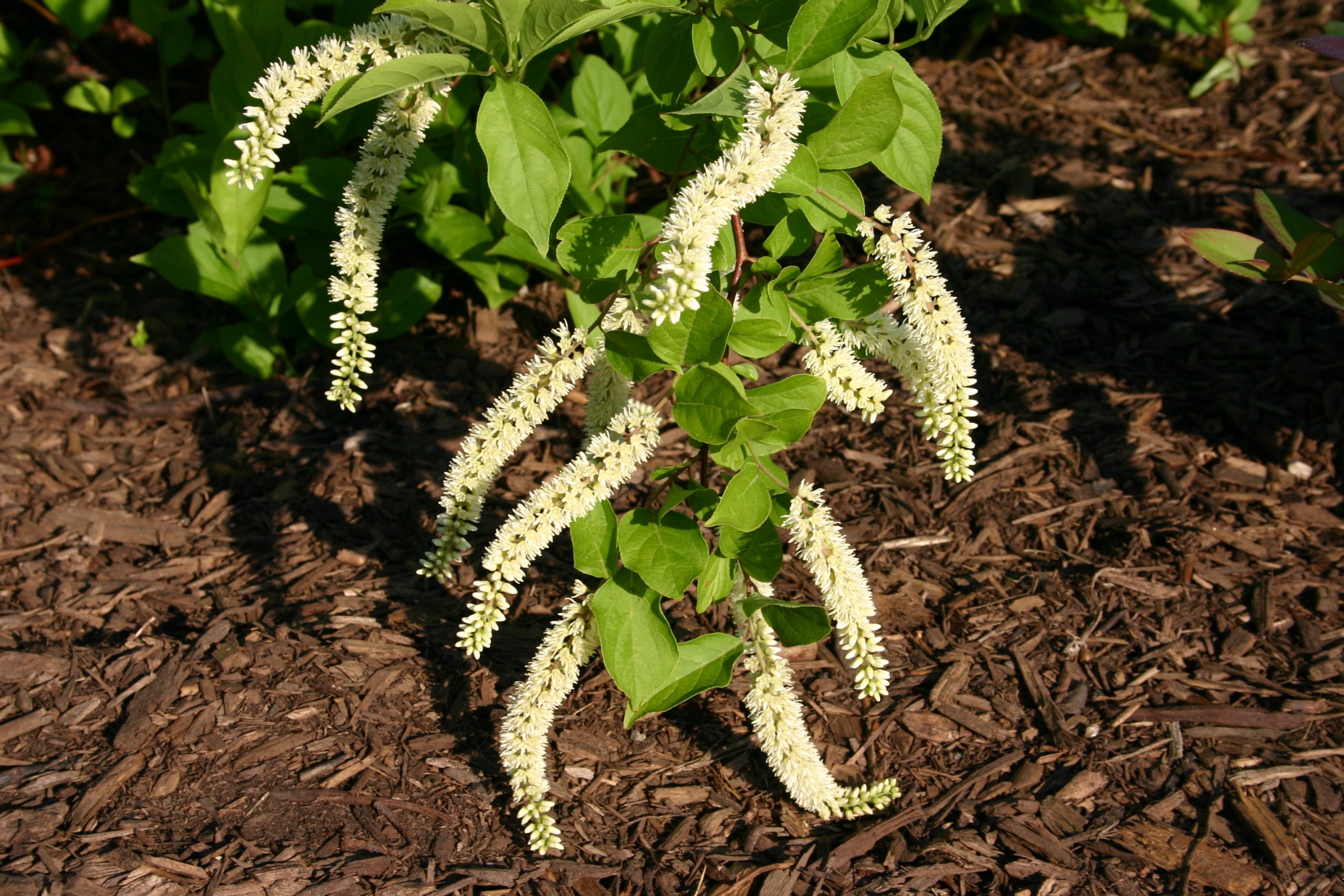
Virginia sweetspire is a perfect choice for landscaping in small or shaded areas. This medium-sized shrub has a rounded growth habit with oval-shaped dark green leaves and creamy white bottlebrush flowers. It can grow up to 3-10 feet (1-3 meters) in height and width. This deciduous shrub is a popular choice for landscaping due to its long blooming period, producing 4″ to 6″ (10-15 cm) long white cylindrical blossom clusters from late spring to fall. The leaves of Virginia sweetspire turn reddish or golden in color during autumn. This shrub can thrive in full sun to complete shade and is easy to grow, making it an excellent addition to any garden.
Growing zones: 5 to 10 Size: 3 to 10 ft. (1 – 3 m) tall and wide Conditions: Full sun to complete shade Difficulty: Easy to grow
Bottlebrush Buckeye (Aesculus parviflora)

Bottlebrush buckeye is an easy-to-grow decorative shrub that has cylindrical white flowers blooming in clusters during the spring and early summer. Its open and spreading habit, along with its palmately compound leaves that can grow up to 8″ (20 cm) long, make it an attractive addition to any garden. This low-maintenance shrub also has large brown pear-shaped seeds with a distinctive whitish scar, also known as buck’s eye. Bottlebrush buckeye can thrive in both full sun and shade, and during autumn, the shrub’s palmate leaves turn into attractive yellow hues with lanceolate leaflets. It can be used as borders, background plants, or informal hedges in any landscape. The growing zones for bottlebrush buckeye are from 4 to 8, and it can grow up to 6-10 ft. (1.8 – 3 m) in size.
Korean Barberry (Berberis koreana)
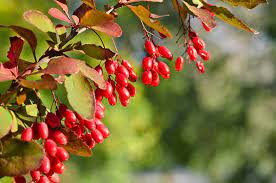
Korean barberry is a semi-evergreen shrub that requires little maintenance and can be used all year round. In the spring, the hardy deciduous shrub produces yellow blooms that hang from its stems, while bright red berries are visible in the fall and winter. The small green leaves of the garden shrub turn maroon and purple in the autumn. This ornamental plant is resistant to deer and thrives in dry environments. It can be used as a screen, wind-shelter, or foundation planting in landscaping. Korean barberry is easy to grow and can be grown in full or partial sun. It is suitable for growing in zones 3 to 7.
Hummingbird Summersweet (Clethra alnifolia)
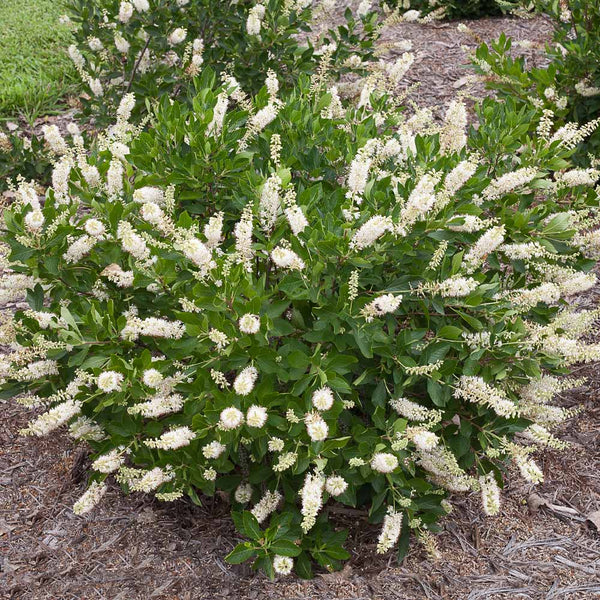
Summersweet is a clumping shrub that is ideal for landscaping in shady gardens. It has lovely lance-shaped leaves, spikes of fragrant white blooms, and a compact growth habit. The Clethra alnifolia ‘Hummingbird’ variety of summersweet is a small white flowering shrub that can grow well in both sunny and shaded environments.
The plant can reach heights of 5 to 10 feet (1.5 to 3 meters) and have a width of 6 feet (1.8 meters). The tiny white flowers of summersweet bloom in mid- to late-summer, attracting pollinators. In the autumn, the deciduous shrub has beautiful golden yellow leaves. The shrub thrives in moist soil and is tough and resilient.
Growing zones: 3 to 9 Size: 5 to 10 ft. (1.5 – 3 m) tall and 4 to 6 ft. (1.2 – 1.8 m) wide Conditions: Full or deep shade, depending on the season Difficulty: Easy to grow as long as it has sufficient water.
Dwarf Blooming Lilac (Syringa meyeri ‘Palibin’)

Meyer Lilac, scientifically known as Syringa meyeri ‘Palibin’, is a perfect fit for small gardens as it has a compact growth habit. The shrub has dark green leaves that turn reddish-bronze in autumn, while its tiny conical flower clusters bloom in light lilac-pink shades. This makes Meyer Lilac an excellent choice for landscaping in urban environments. Being drought, heat, and soil tolerant, this slow-growing dwarf Korean lilac is a low-maintenance ornamental plant that is easy to grow in full sun conditions.
Growing zones: 3 to 7 Size: 4 to 5 ft. (1.2 – 1.5 m) Conditions: Full sun Difficulty: Low-maintenance, drought-tolerant
Rose of Sharon (Hibiscus syriacus)
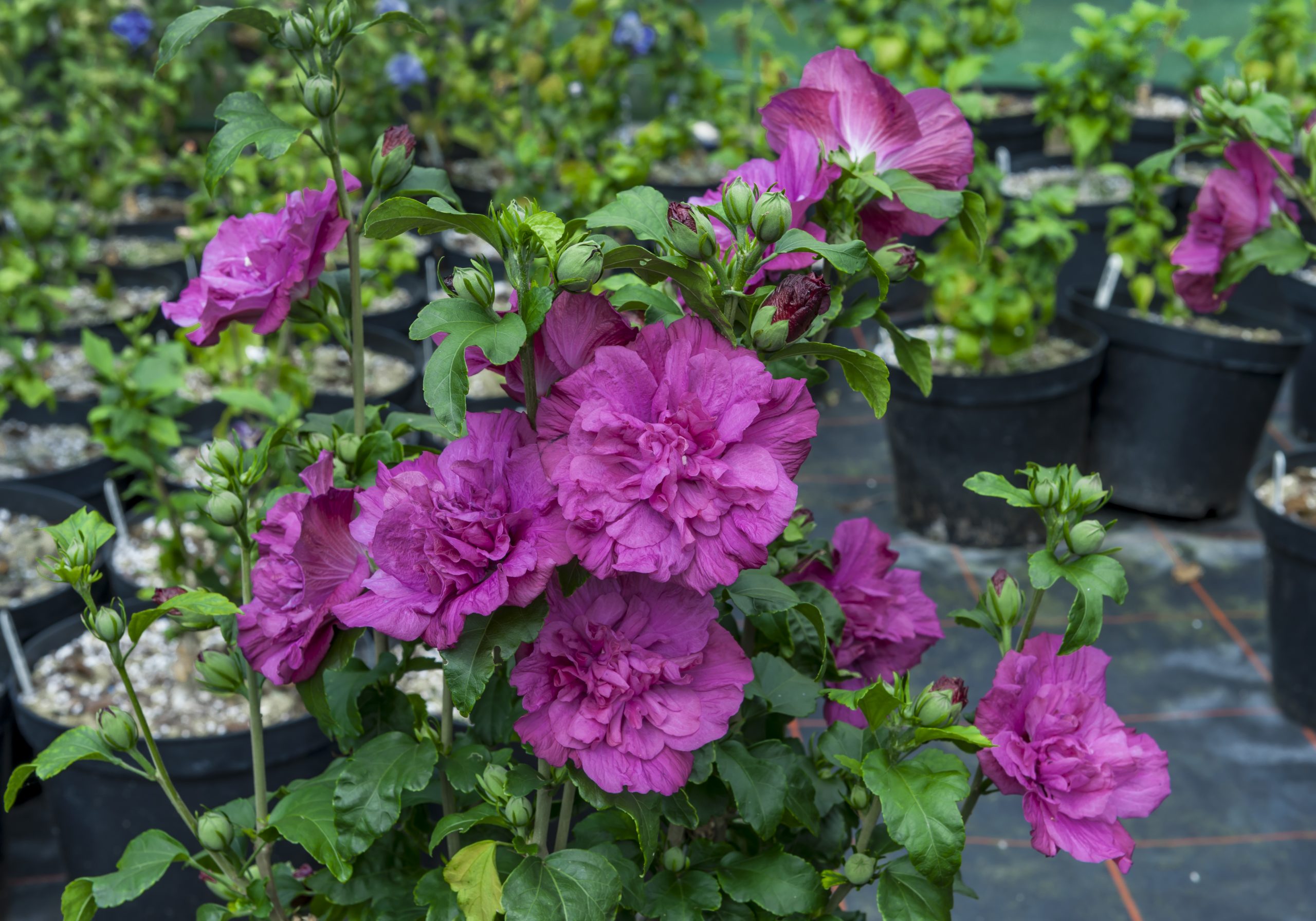
Rose of Sharon, also known as Hibiscus syriacus, is a deciduous plant that produces stunning flowers in a variety of colors such as red, white, pink, light blue, or lilac. Despite its shrub-like appearance, it can also grow into a small tree. This plant belongs to the Malvaceae family, which includes other species of mallow plants. It is known by other names such as Althea tree, Korean rose, and Chinese hibiscus.
Growing zones: 5 to 8 Size: 8 to 12 ft. (2.4 – 3.6 m) Conditions: Well-drained soil and partial shade are preferred. Difficulty: Low-maintenance and easy to cultivate.
Common Ninebark (Physocarpus opulifolius)
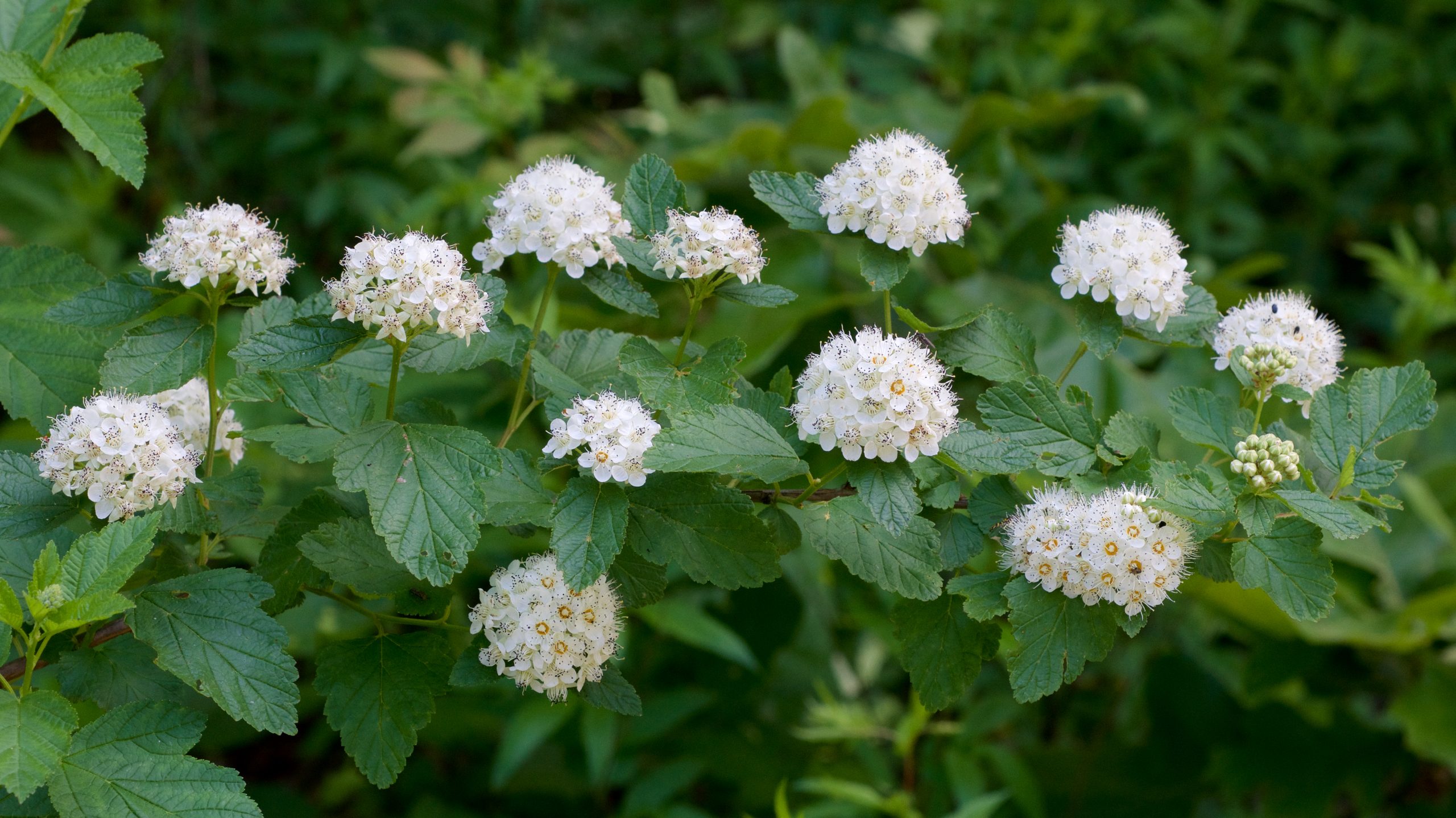
Ninebark is a fast-growing bushy landscape shrub that thrives as a foundation shrub or bloom hedge. The arching stems, yellowish-green leaves, dark brown exfoliating bark, and pinkish-white flowers of the deciduous plant indicate upward, spreading growth. In the fall, drooping crimson fruit clusters emerge after blooming. Ninebark grows to be 5 to 8 feet (1.5 to 2.5 meters) tall and broad.
The hardiness and pest resistance of common ninebark plants is well-known. In cold or temperate regions, you can plant the shrub as a specimen bush, deciduous hedge, or screen. If the plant doesn’t get enough water, it may succumb to hot conditions.
Growing zones: 2 to 8
Size: 5 to 8 ft. (1.5 – 2.5 m) tall and up to 6 to 10 ft. (1.6 – 3 m) wide
Conditions: Part sun, part shade
Difficulty: Medium maintenance required
Purple Ninebark (Physocarpus opulifolius ‘Monlo’)

Ninebark is a popular landscape shrub that grows quickly and can be used as a foundation plant or a hedge. The deciduous plant has arching stems, yellowish-green leaves, dark brown peeling bark, and pinkish-white flowers, all of which indicate upward, spreading growth. In the fall, drooping crimson fruit clusters appear after blooming. Ninebark can grow up to 5 to 8 feet (1.5 to 2.5 meters) tall and broad.
Ninebark is known for its hardiness and resistance to pests. It can be planted as a specimen bush, deciduous hedge, or screen in cold or temperate regions. However, the plant requires regular watering to survive in hot and dry conditions.
Growing zones: 2 to 8 Size: 5 to 8 ft. (1.5 – 2.5 m) tall and up to 6 to 10 ft. (1.6 – 3 m) wide Conditions: Part sun, part shade Difficulty: Moderate maintenance required
Honeysuckle Shrubs

Lonicera xylosteum, a small honeysuckle plant, has compact growth and fragrant flowers. When grown indoors, they reach a height of 3 to 6 feet (1.8 to 2.4 meters) and produce pearl-pink or pearl-yellow blooms with four slender petals. After flowering, honeysuckle shrubs produce clusters of shiny crimson, pink, or orange berries.
Blue honeysuckle or honeyberry, such as the Blue Moon and Borealis varieties, are cold-hardy deciduous shrubs that grow up to 3 feet (1 meter) tall. The edible blue, blueberry-like berries are yellowish-white in color and bloom from the blossoms of blue honeysuckle.
These are compact, fragrant blooms that resemble perennial climbing honeysuckles. Regular honeysuckle fruits should not be consumed, unlike blue honeysuckle.
Growing zones: 4 to 9 Size: 3 to 6 ft. (1 – 1.8 m) tall, depending on the species Conditions: Full to partial sun Difficulty: Keep invasive non-native shrubs under control to prevent their growth.
Mountain Laurel (Kalmia latifolia)

Mountain laurel, also called spoonwood or ivy bush, is an evergreen shrub that can tolerate partial shade in the landscape. The leathery and glossy green leaves provide an attractive backdrop for large clusters of light pink hexagonal blooms that bloom throughout the summer. The shrub can reach a height of 5 to 15 feet (1.5 to 4.5 meters) and makes an excellent specimen plant in a garden, as well as in a cottage garden or as a shrub border. Deadheading the flowers can extend the blooming period. Mountain laurel is a low-maintenance shrub that is easy to grow. It produces brown fruit after flowering. Mountain laurel grows in zones 4 to 9.
Potentilla Shrubs (Potentilla fruticosa)
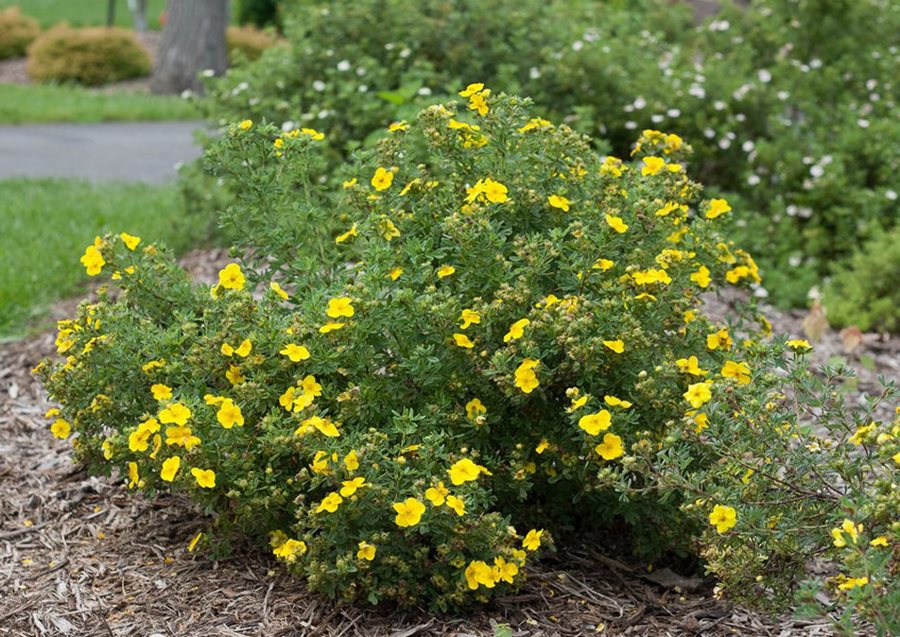
Potentilla fruticosa is a low-growing shrub with different cultivars that can produce yellow, orange, pink, or white blooms. During the summer, these plants are covered with masses of flowers that can be pink, orange, red, white, or yellow. It can grow up to 3 feet (1 meter) tall and is also known as shrubby cinquefoil or golden hardhack.
Potentilla is one of the easiest shrubs to grow, and it can tolerate drought and freezing temperatures. Plant it in full sun as an informal hedge, specimen bush, or along the borders. It is an excellent choice for a simple landscaping shrub that blooms all summer long.
Growing zones: 3 to 7 Size: 2 to 4 ft. (0.6-1.2 m) tall and 3 to 5 ft. (1-1.5 m) wide Conditions: Full sun to partial shade Difficulty: Very easy to grow
Types of Decorative Evergreen Shrubs to Grow in Your Yard (With Pictures and Names) – Identification Guide
For a beautiful garden landscape, shrubs that are green all year round are required.
Winter Creeper (Euonymus fortunei)
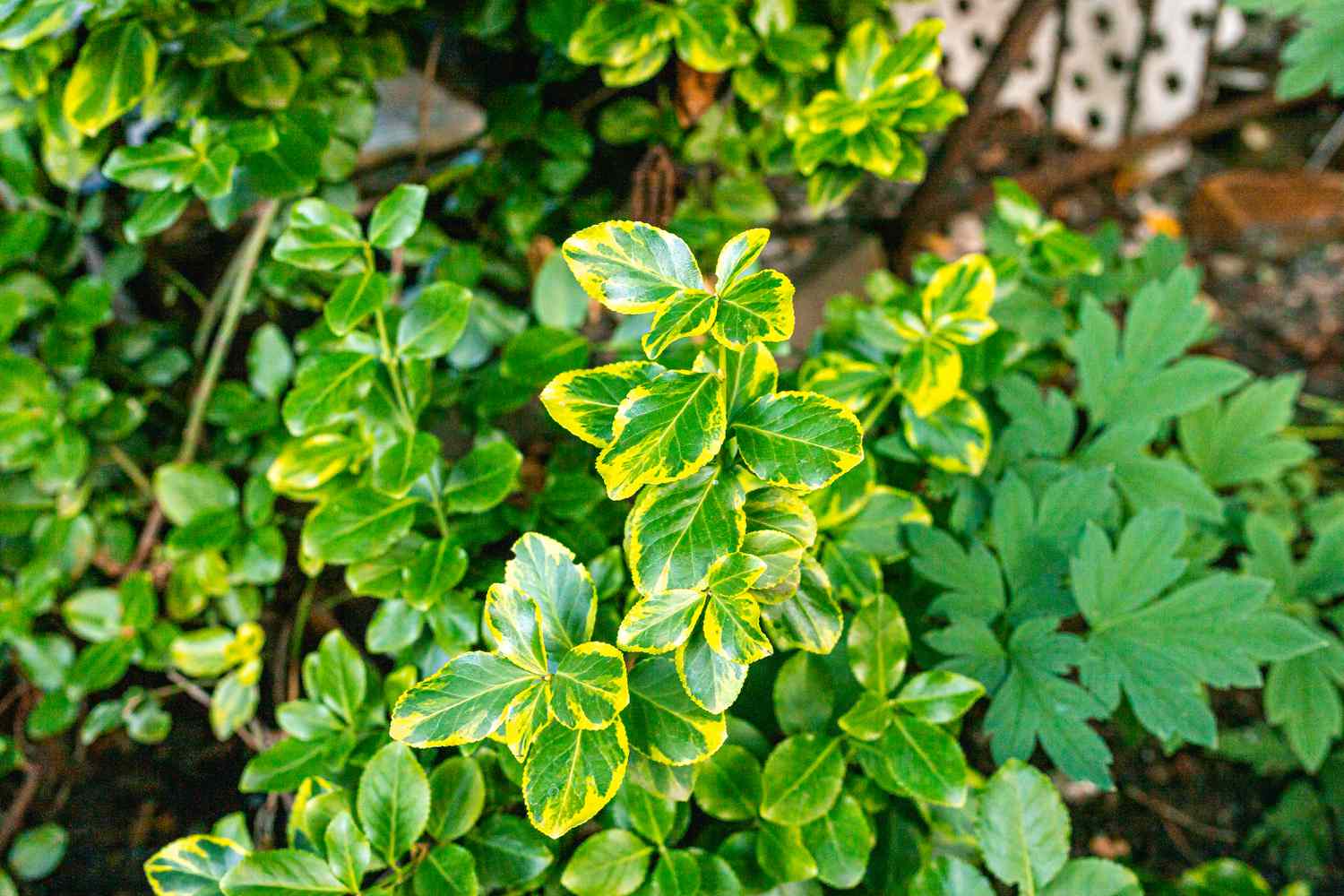
The Winter Creeper is a small, evergreen shrub that adds brightness to any garden with its vibrant foliage. It is a low-growing plant with variegated ovate leaves and dark brown-gray bark, and it is available in compact cultivars like Emerald n’ Gold, Emerald Gaiety, and Moonshadow. This shrub is easy to care for, and it produces greenery and foliage all year round. It can be used as a ground cover or in pots, and it is ideal for planting in front of the house.
The Winter Creeper is a hardy evergreen landscaping shrub that requires low maintenance. It can be planted en masse to create a low hedge or used as foundation plants, and it can also be trained to climb trellises or garden walls. The ‘Blonde Beauty’ cultivar of the Winter Creeper has multicolored leaves that provide your yard with lovely yellow and green tones throughout the winter. This shrub can thrive in full sun and shady areas.
Other Winter Creeper cultivars, such as the ‘Emerald Gaiety,’ ‘Emerald n’ Gold,’ ‘Fortune’s Spindle,’ and ‘Emerald Surprise,’ are also excellent choices for your garden. This landscaping shrub is also known as Spreading euonymus, Japanese euonymus, and climbing euonymus.
Growing zones: 5 to 9 Size: Up to 24 inches (60 cm) tall and spread of 40 inches (100 cm) Conditions: It can grow in full sun, partial shade, or full shade, and it does well in well-drained soil or poor soil. Difficulty: This shrub is very easy to grow.
European Box Plant (Buxus)

Boxwood plants are versatile shrubs that can be used to create both formal and informal hedges in the front of a house. These slow-growing evergreens have thick green leaves, and depending on the cultivar, variegated options with yellow and green leaves are also available.
Boxwoods are excellent choices for creating privacy hedges as they can grow to medium size and have a compact habit. For instance, the ‘Sprinter’ cultivar of Buxus microphylla is a small variety that is best suited for growing in zones 5-8 and only grows to a height of 3 feet (120 cm).
When it comes to growing boxwoods, they require partial shade and well-draining soil, which can be sandy or heavy clay. They need some pruning in the summer, but overall they are easy to grow. Growing zones for boxwoods range from 5 to 8, and there are cultivars available that can range in size from 3 ft. (0.9 m) to 30 ft. (9 m).
Japanese Laurel (Aucuba japonica)
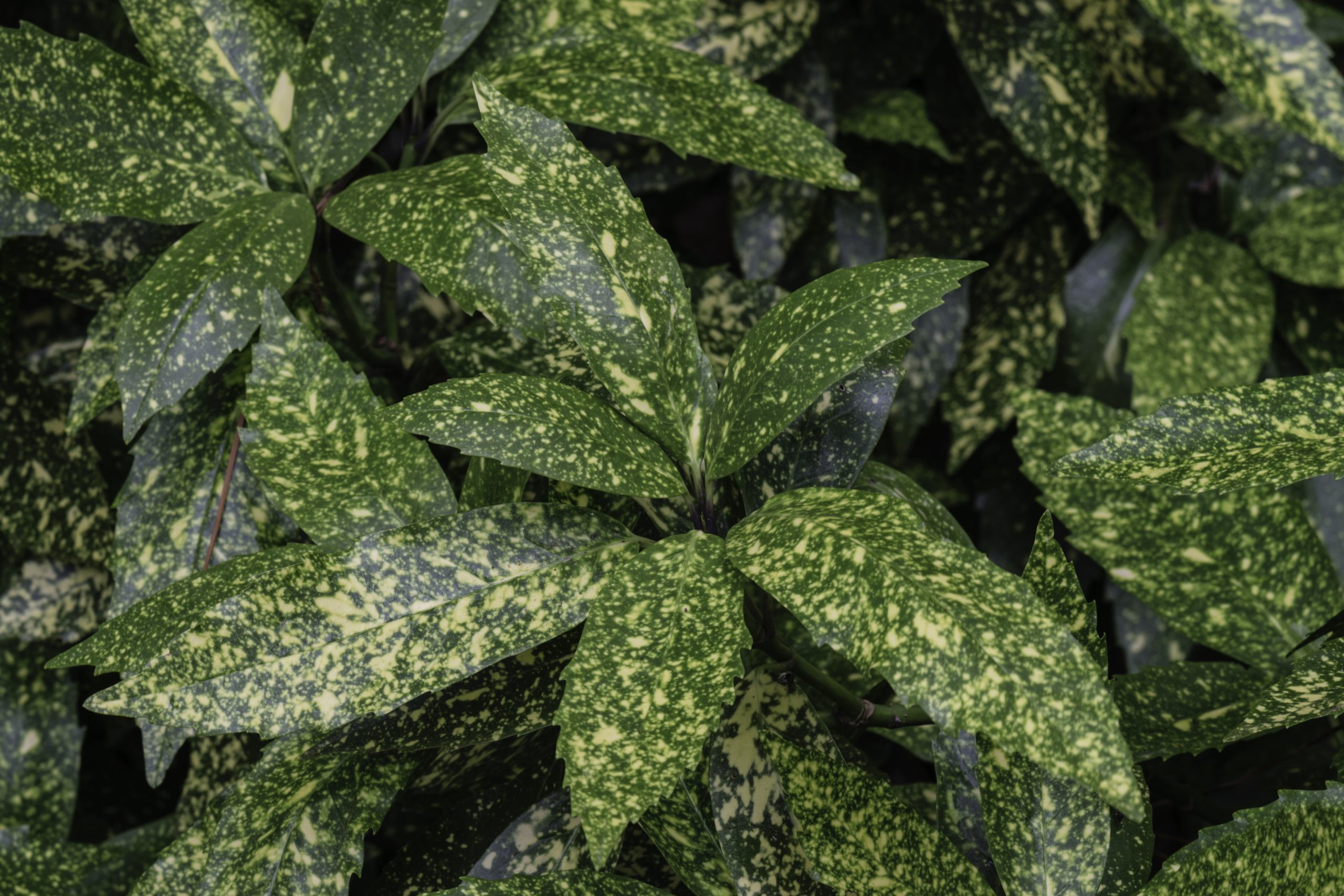
Spotted laurel is a fantastic evergreen shrub for shaded areas and partial sun. It is a popular landscaping shrub that makes for an excellent evergreen hedge in front or back yards. The Japanese Laurel is a stunning shrub with large, broad evergreen leaves that grows well in shady areas. The Gold Dust plant or Spotted Laurel is another name for this low-maintenance bush.
If you’re looking for a sturdy shrub for a shady spot in your garden, Japanese Laurel cultivars are an excellent option. Many cultivars have variegated leaves, which means they have two or three colors. They have large, glossy leaves that provide a bright color in your garden.
Several types of Japanese Laurel produce small, insignificant flowers during the summer. In autumn, the bright crimson berries appear, adding vibrant colors to your garden. The ‘Crotonifolia’ shrub has bright yellow leaves with green speckles, making it one of the most popular Japanese Laurel cultivars. Another popular shrub is the ‘Golden King,’ which has green leaves with yellow blotching.
Growing zones: 6 to 10 Size: Between 6 and 10 ft. (1.8 – 3 m) tall and a spread of 5 to 9 ft. (1.5 – 2.7 m) Conditions: Partial sun and shade. Grows well in most soil types, and the soil should be dry or moist. Difficulty: Low maintenance and easy to care for.
Fatsia Japonica
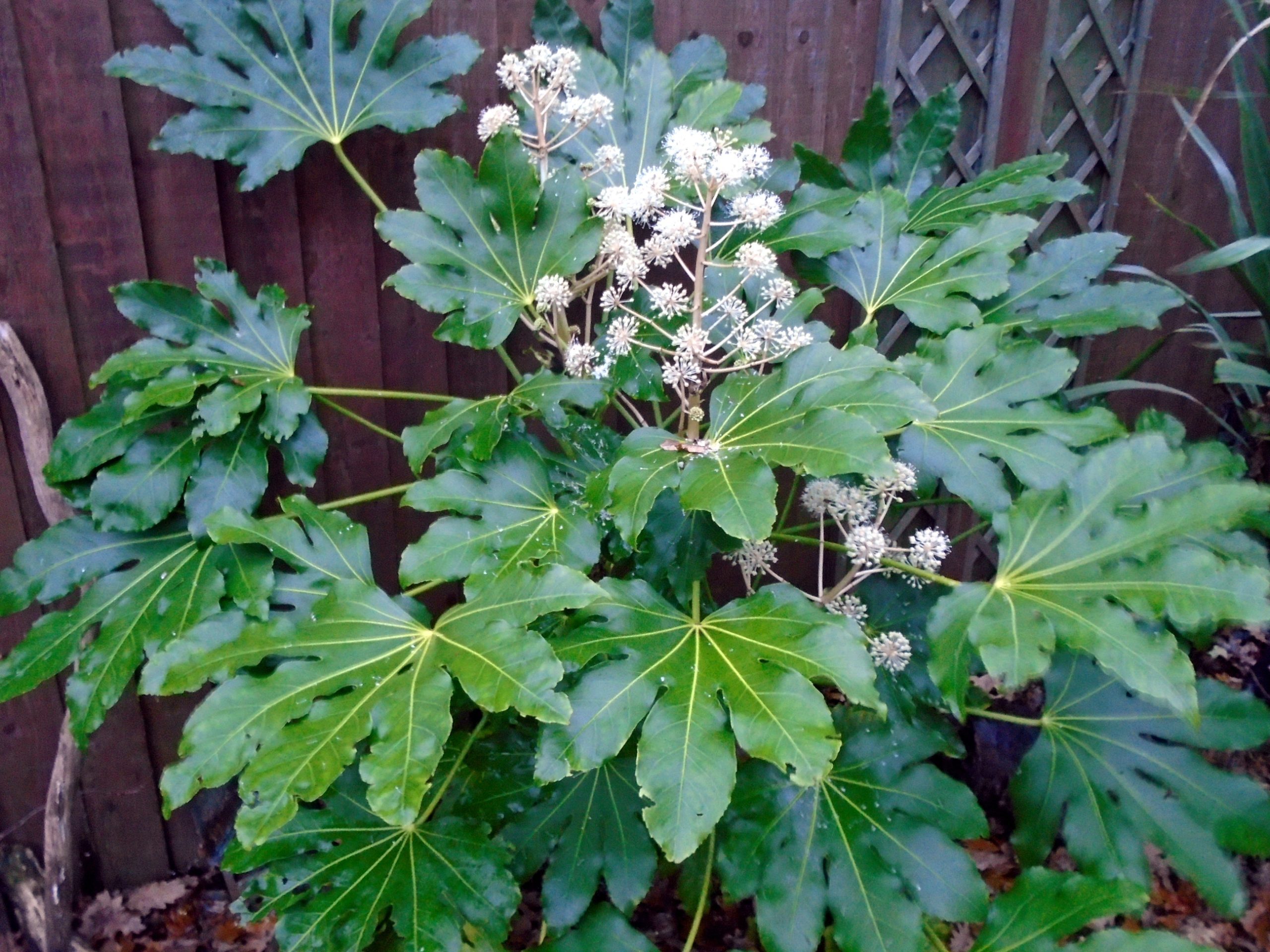
The Fatsia japonica is a stunning evergreen shrub that requires minimal maintenance, making it an excellent choice for shaded areas. This hardy plant is known for its rapid growth and ability to cover large areas with its large glossy leaves, which can reach up to 18 inches (45 cm) in width.
During the summer, the Fatsia japonica produces clusters of small white flowers that add to its already impressive beauty. For those looking to add some extra color to their garden, the Fatsia japonica ‘Variegata’ cultivar features dark green leaves with streaks of yellow and white.
Growing zones: 7 to 10 Size: Up to 8 ft. (2.4 m) tall Conditions: Partial shade. Can grow in a variety of soils. Difficulty: Basic and regular pruning is necessary to keep the plant in check.
Photinias

Photinia x fraseri ‘Red Robin’ is a well-known evergreen hedge shrub with leaves that emerge as red and mature into green. The Photinia genus comprises ornamental plants with attractive foliage colors that are ideal for privacy hedges. These Photinia cultivars grow well in moderate regions and maintain their green foliage all year round. One of the reasons for their popularity is the red leaves that bloom in the spring and summer. These large garden plants make excellent year-round hedges.
Red Tip Photinia (Photinia fraseri) is one of the most commonly cultivated Photinia varieties. As new leaves mature, they turn from red to green. ‘Red Robin,’ ‘Pink Marble,’ and ‘Scarlet Blaze’ are some of the most popular Photinia shrub cultivars with red leaves.
Growing zones: 7 to 11 Size: Depending on the cultivar, it can reach up to 4 feet (3 meters) in height and width. Conditions: Photinia can tolerate full or partial sunlight. Most soil types are suitable for growing Photinia, but nutrient-rich soil is required for vibrant red foliage. Difficulty: It is straightforward to cultivate, but regular pruning is necessary to maintain its shape.
Daphne Odora
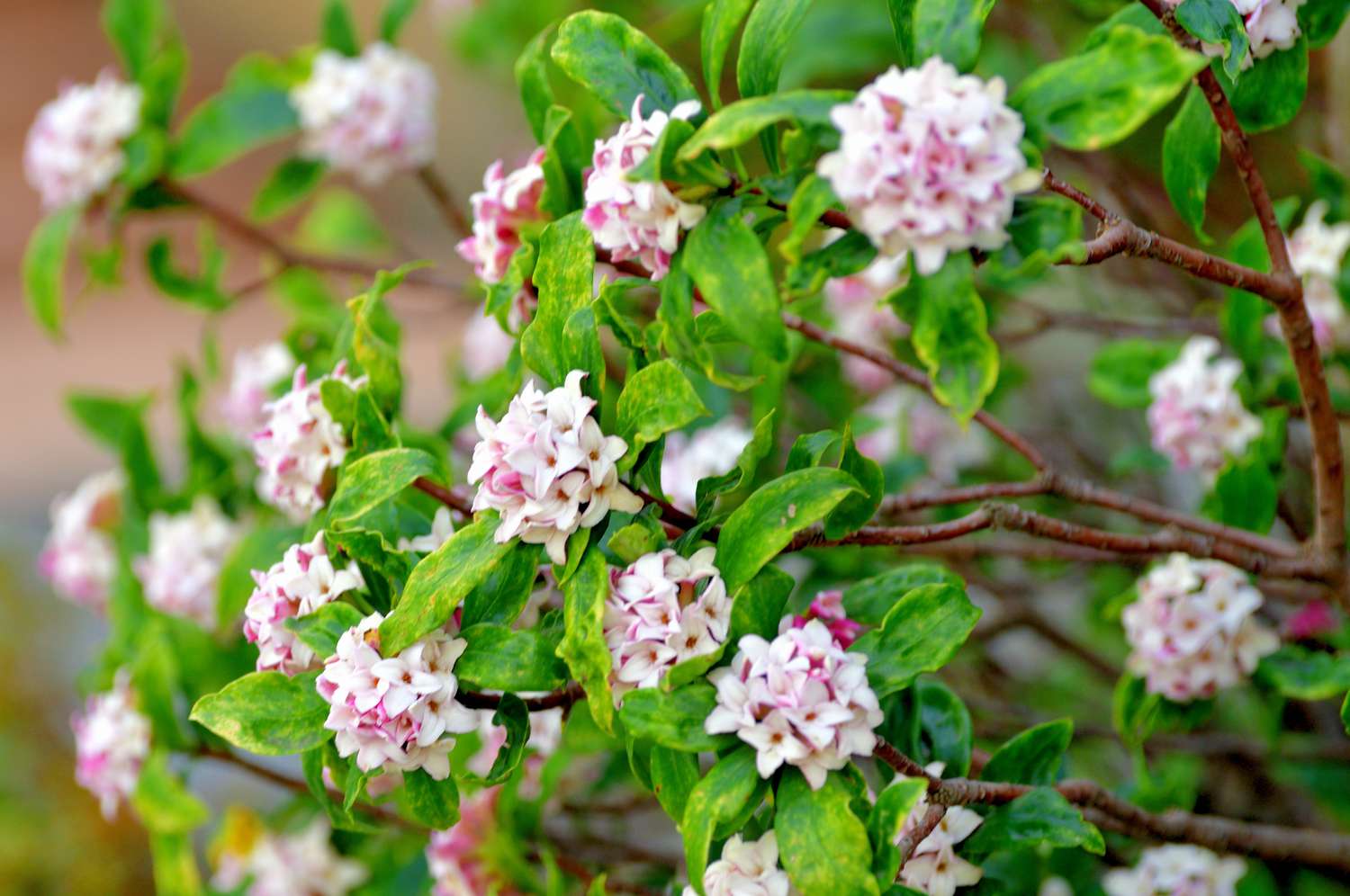
Daphne Odora is a low-maintenance, flowering evergreen shrub that produces fragrant pink and purple blooms in late winter and early spring. The shrub has beautiful dark-green leaves with yellow edges, providing year-round color to your garden.
One of the hardiest Daphne shrubs is the Daphne with a Golden Edge (Daphne ‘Aureomarginata’), which features gold-edged leaves. However, it’s important to note that the leaves of this evergreen plant are poisonous to humans and animals if ingested, so it may not be suitable for all gardens.
Growing zones: 7 to 9 Size: 3 to 6 ft. (1 – 1.8 m) Conditions: Full or partial shade, well-draining loamy or clay soils Difficulty: These plants have a lifespan of around ten years and may require some effort to establish.
Japanese Pieris (Pieris japonica)

The Japanese pieris is an eye-catching evergreen shrub that features young pinkish-red leaves turning into glossy green oblong leaves. The shrub can grow up to 9-13 feet (2.7 to 4 m) tall and 8 feet (2.4 m) wide, and produces beautiful white and pink flowers that resemble lily-of-the-valley blossoms in spring and summer. It can be grown in both full sun and partial shade, and is perfect for foundation planting, specimen bush, or evergreen hedge.
In addition to the Japanese pieris, there are many low-growing shrubs and bushes that require little to no care. Juniper, cypress, and spruce trees are some examples of coniferous trees that can provide low-maintenance and evergreen foliage for landscaping. These trees and shrubs offer a variety of options for creating an attractive and easy-to-maintain yard.
Siberian Carpet Cypress (Microbiota decussata)
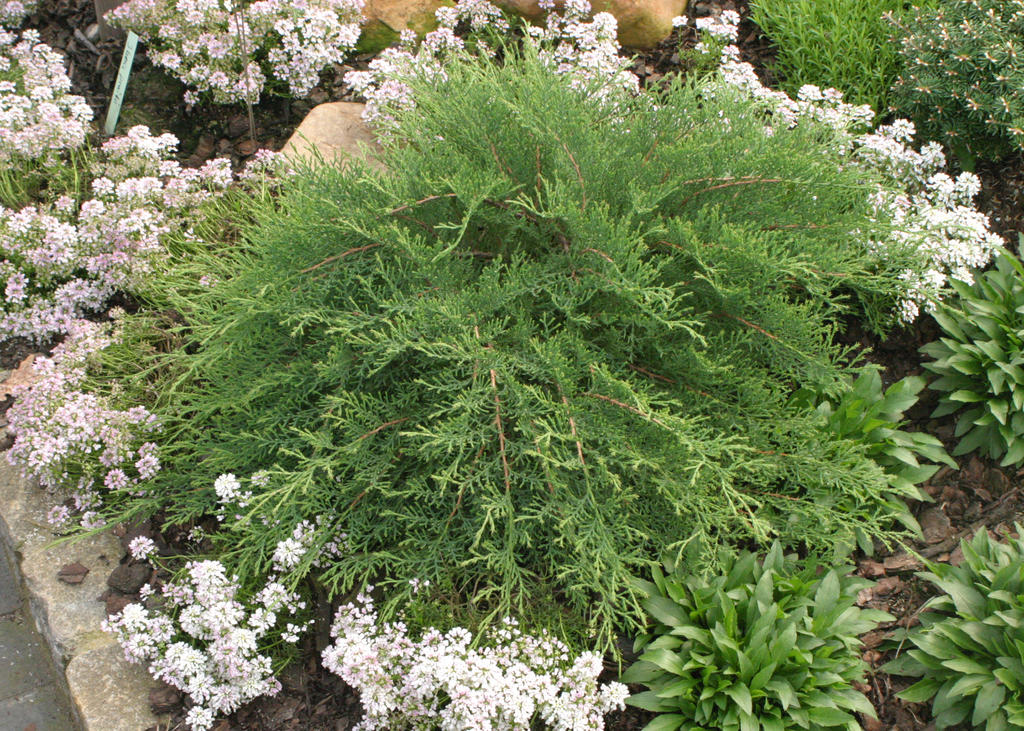
The Siberian carpet cypress is an evergreen shrub that grows close to the ground and flourishes in areas with full sun and cool shade. It’s an excellent option for a ground cover bush. The Siberian carpet cypress can create a lush green carpet once it is established and spreads out along the ground. This spreading shrub can withstand harsh winters and is drought resistant.
Growing zones: 2 to 7 Size: Up to 40 inches (1 m) high and a spread of up to 40 inches (1 m) Conditions: Requires bright and sunny surroundings. Thrives in moist and well-drained soil. Difficulty: Requires minimal care and is easy to cultivate.
Siberian Carpet Cypress (Microbiota decussata)
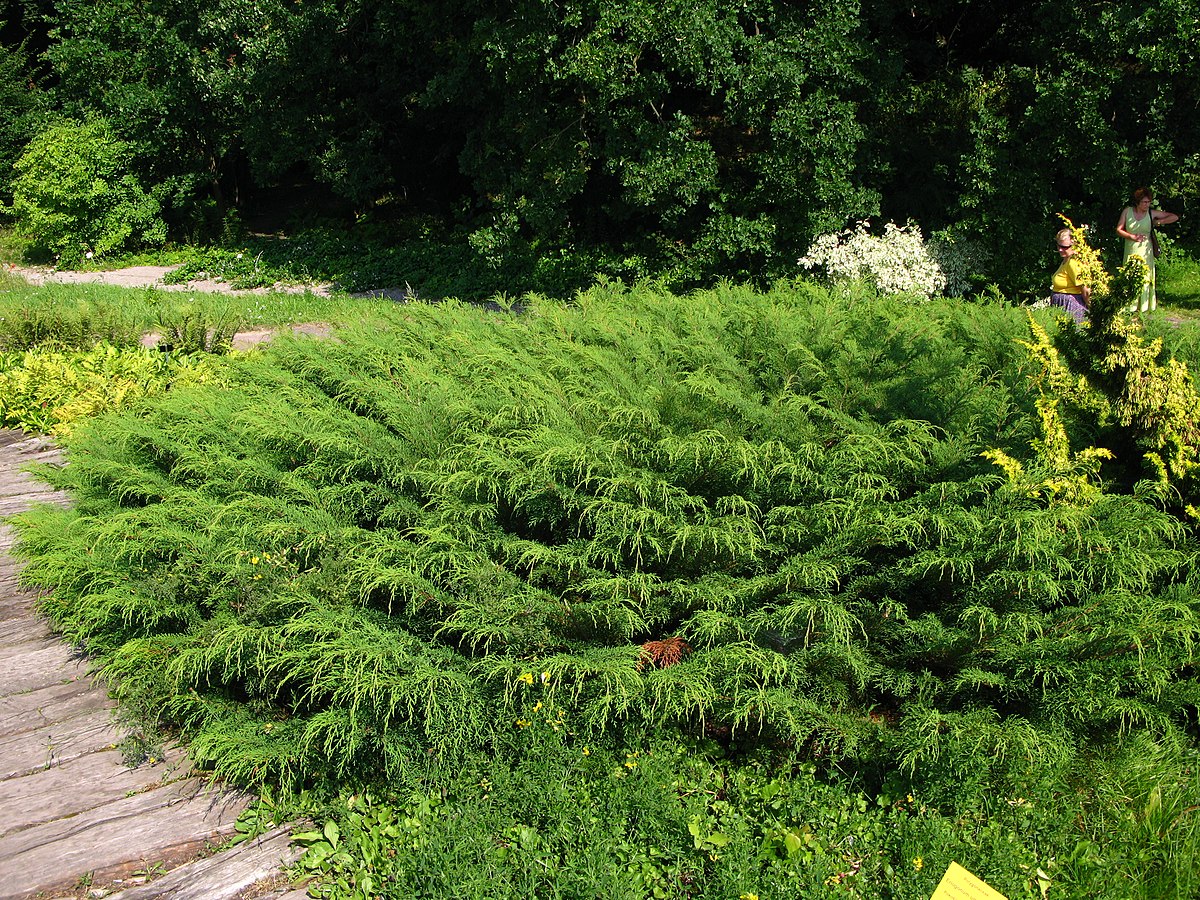
The Siberian carpet cypress is a hardy evergreen shrub that can thrive in both sunny and shady areas of your garden. It’s an excellent choice for ground cover due to its low-growing nature and ability to spread out quickly after planting. This coniferous shrub is drought tolerant and can withstand harsh winter conditions. It prefers moist, well-drained soil and grows best in growing zones 2 to 7. The Siberian carpet cypress can reach a height of 40″ (1 m) and has a spread of up to 40″ (1 m). With minimal maintenance, it’s an easy shrub to care for.
Juniper ‘Blue Star’ (Juniperus squamata ‘Blue Star’)
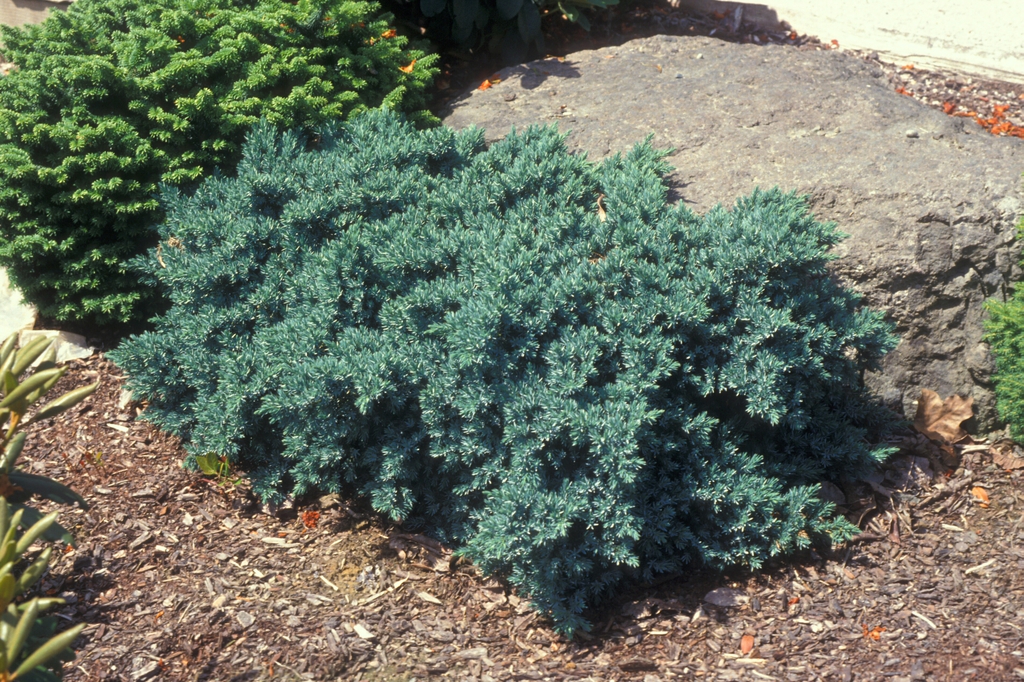
Juniper shrubs, including the ‘Blue Star’ cultivar, are low-maintenance plants that come in a range of colors. The Blue Star juniper is an excellent choice for ground cover due to its slow-growing, silvery carpet-like foliage. This hardy shrub thrives in growing zones 4 to 8 and can reach a height of 24 to 36 inches (60-90 cm) with a spread of 3 to 4 feet (90-120 cm). It prefers full sun and well-draining soil, but can tolerate various soil types. With minimal care, this shrub is easy to maintain and keep tidy.
Yew ‘Densiformis’ (Taxus media ‘Densiformis’)
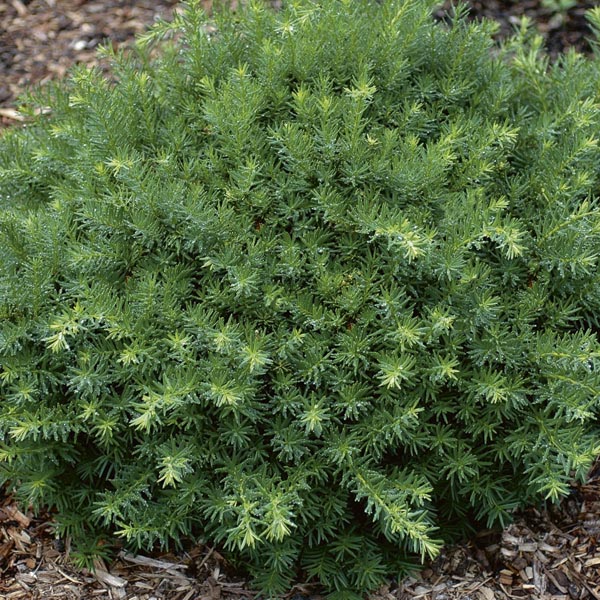
The ‘Densiformis’ dwarf spreading yew is an excellent choice for the front of your house as it provides good ground coverage and is an evergreen plant. The needles on its branches create a dense foliage that is both attractive and protective. This dwarf yew variety can reach a height of 3 feet, making it a suitable choice if you need some elevation. Additionally, it can grow into a bushy shrub in shady areas.
This yew plant thrives in growing zones 4 to 7 and can reach a height of 3 to 4 feet with a spread of 4 to 6 feet. It can tolerate full sun to partial shade and is adaptable to a variety of soil types, including light sandy soils and heavy clay soils with good drainage. With minimal care requirements, this plant is easy to maintain and doesn’t require much upkeep.
Dwarf Norway Spruce (Picea abies ‘Little Gem’)
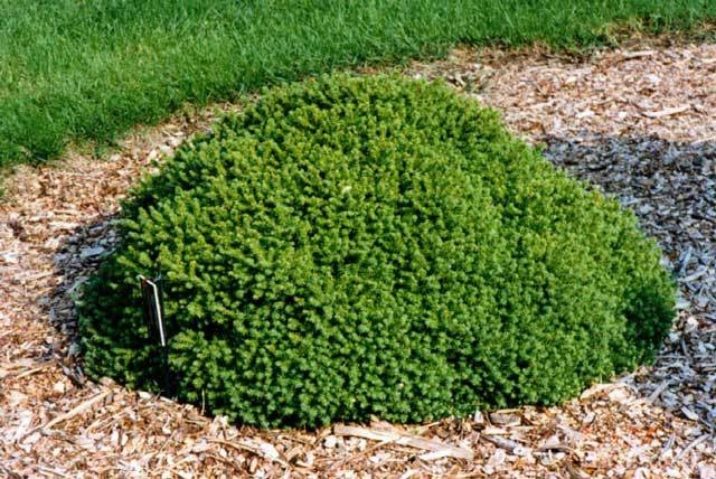
The Dwarf Norway Spruce is an ideal choice for the front of your house due to its evergreen nature and flattened spherical leaves. Dwarf spruce tree varieties are perfect for those who want low-maintenance, small, and shrubby conifers in their garden.
For instance, the Norway spruce cultivar ‘Little Gem’ grows to a height of under a foot (30 cm) and forms a compact, cushion-like shrub. You can plant this tiny shrub in small gardens with limited space. Alternatively, you can plant several shrubs together for excellent ground coverage that requires minimal upkeep.
The Dwarf Norway Spruce thrives in growing zones 3 to 8 and can reach a size of 10 to 12 inches (25-30 cm) with a spread of the same size. It prefers partial to full sun and thrives in moist or damp soil conditions. This plant grows well in neutral to acidic soil, and it’s easy to care for, making it an ideal option for those who want low-maintenance plants.
Juniper ‘Sea Green’ (Juniperus pfitzeriana ‘Sea Green’) and Juniper ‘Mathot’
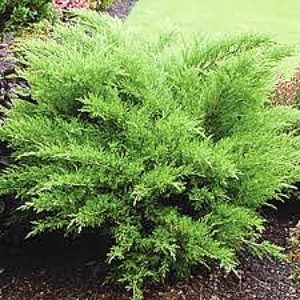
The “Mathot” Juniper is a decorative and easy-to-grow evergreen shrub that can add to the beauty of your garden. This shrub has a cascading effect due to its arching branches, making it an excellent choice for landscaping purposes. Another cultivar of Juniper, the ‘Sea Green,’ has soft leaves that change color from minty-green to bluish-green as the summer progresses. This low-maintenance plant can be used for medium-height ground cover or as a hedge.
Apart from these junipers, there are many other landscaping shrubs available that offer unique features like colorful foliage or red/purple berries. With their distinct appearances and characteristics, they can add charm and variety to your yard.
Japanese Barberry (Berberis thunbergii)
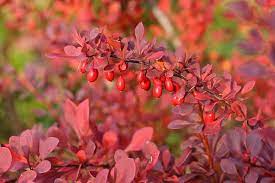
The Japanese barberry is a landscaping shrub that can be used as a security hedge due to its thorny nature. It is well-known for its small, oval leaves that range in color from brilliant to deep red, as well as its aromatic light yellow spring blossoms and bright red fruits. After the leaves fall, the shrub’s spiky, upright stems become visible. Also known as Thunberg’s barberry, this shrub has a rounded growth habit and can serve as a privacy hedge or barrier for protection. It can also be grown as a single specimen plant in borders and beds.

The purple Japanese barberry, also known as Berberis thunbergii f. purpurea or Atropurpurea, is a thorny shrub with striking purple leaves. It grows to be 3 to 6 feet tall and 4 to 7 feet wide, making it a great option for a hedge or border plant. It can tolerate full sun to partial shade and requires moderate to high maintenance. The purple Japanese barberry is a beautiful addition to any landscape design, but be careful when handling it as its thorns can be quite sharp.
Red Twig Dogwood (Cornus alba)

During the winter season, red twig dogwood bushes are a great addition to your landscape as they add a pop of color. These shrubs are perfect for landscaping if you are looking for stunning red-barked shrubs with white flowers. The deep red color of the stems becomes more prominent in the fall and winter months, making them stand out in your garden.
Red twig dogwood bushes are particularly striking when paired with evergreen plants in your garden. These shrubs have light green leaves during the summer and some cultivars, like ‘Elegantissima,’ have tiny white flowers, adding contrast to the flowering shrub.
The red twig dogwood is a hardy plant that can grow in most soil environments. For the deepest red colors on the bush, it is best to plant it in a sunny location. It can grow up to 10 feet (3 meters) tall and has a spread of up to 6 feet (2 meters). It is relatively easy to grow in well-drained soil. The plant can thrive in growing zones as low as 3.
Persian Shield (Strobilanthes dyerianus)
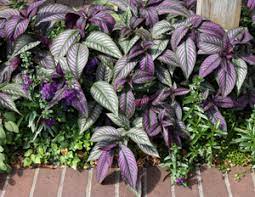
The Persian Shield is an attractive purple-colored bush that requires minimal maintenance and thrives in warm weather. This decorative evergreen shrub has purple leaves that are not shed in the winter, and can be utilized as a groundcover. Persian Shield plants require warm climates to survive, and their foliage can range in color from lilac to deep purple. Some cultivars also have long, lance-shaped leaves with pointed tips.
The Persian Shield is typically grown in zones 9 or 10, but can also be cultivated as an indoor houseplant. The plant can grow up to 5 feet tall, but pruning can help maintain its height. It thrives in well-drained, organically rich soil and requires full sun exposure. Cultivating a Persian Shield plant is easy and can quickly spread.
Heavenly Bamboo (Nandina domestica)

Heavenly bamboo is a small and slow-growing shrub that produces crimson berries and summer-green leaves that turn crimson in the fall. In the spring, the semi-evergreen nandina shrub bears tiny white flowers that develop into large crimson berries during the fall and winter.
The shrub’s foliage turns reddish-purple in the autumn, then purple, and eventually green. It can reach a height and width of up to 4 feet (1.2 meters) and is ideal for planting as an informal hedge, foundation planting, woodland garden, or shrub border.
Growing zones: 6 to 9 Size: 4 to 8 ft. (1.4 – 2.4) tall and 2 to 4 ft. (0.6 – 1.2 m) wide Conditions: Heavenly bamboo shrubs thrive in full sun and shade. They prefer moist, well-drained, and fertile soil and can adapt to different soil types. Difficulty: This plant requires high maintenance as suckers must be removed regularly.
American Beautyberry (Callicarpa americana)
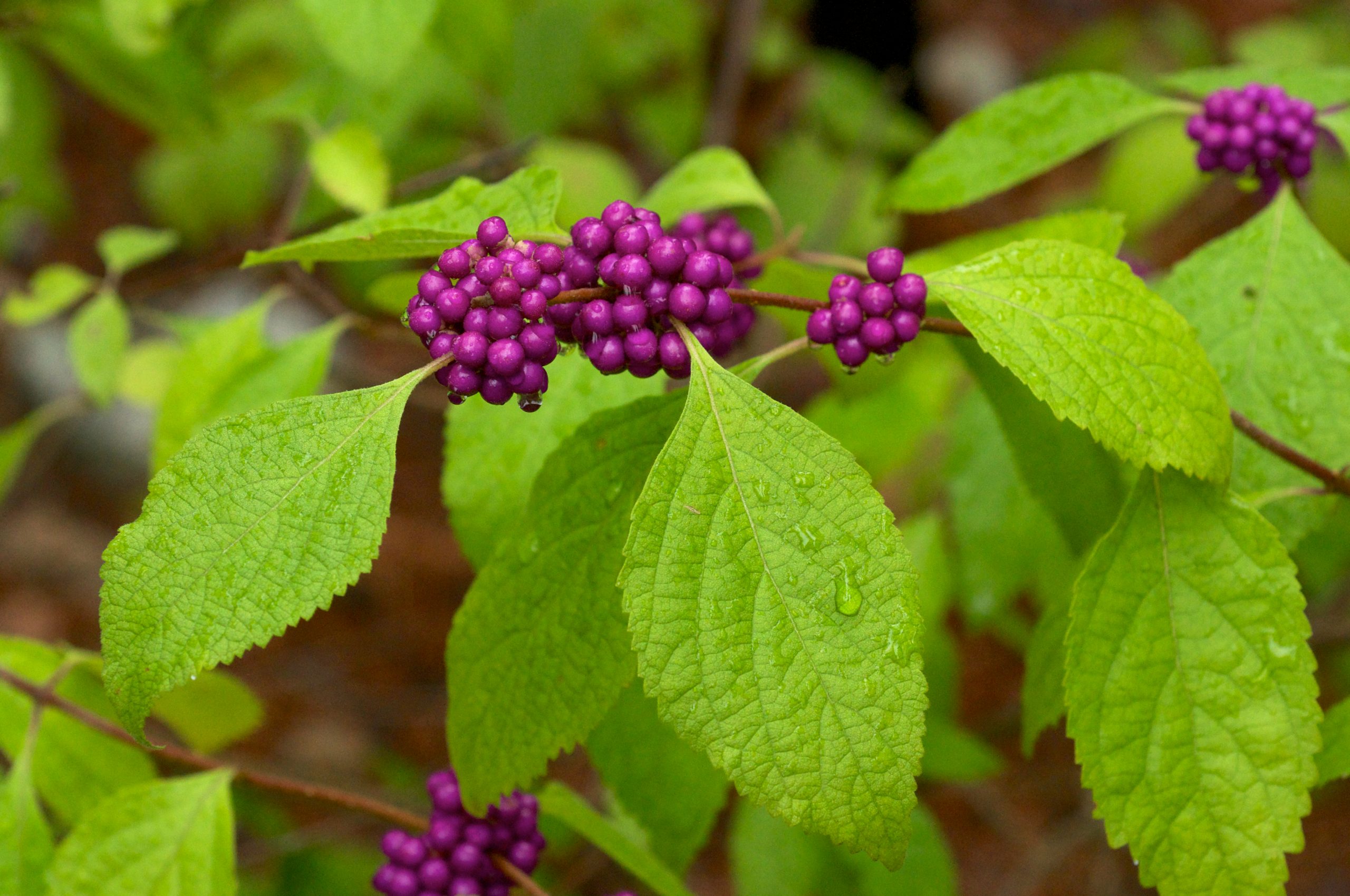
American beautyberry is a beautiful shrub that is perfect for subtropical regions. It is a small ornamental shrub with purple berries that grow in clusters on arching stems. The tiny, spherical magenta berries are the highlight of this deciduous shrub. The shrub also has light green leaves that are fuzzy and enormous, which turn yellow in the fall. Moreover, it has little pink, violet, or white spring blooms.
The American beautyberry shrub, also known as French mulberry, is fast-growing with a loose and open habit. This drought-tolerant shrub can grow up to 3 to 6 feet (1.8 to 2 meters) tall and wide and requires very little care. In a backyard landscape, the shrub looks stunning at the back of the border.
Growing zones: 6 – 11 Size: 3 to 6 ft. (1 – 1.8 m) tall and wide Conditions: Full sun or partial sun Difficulty: Low maintenance, easy to grow.
